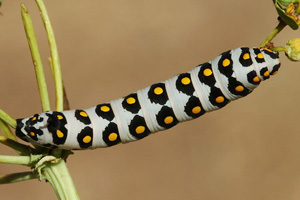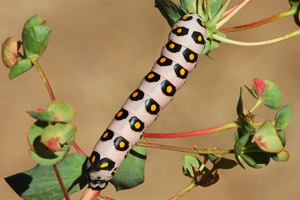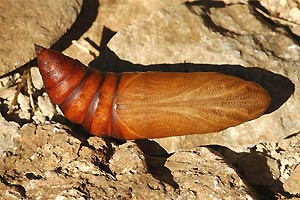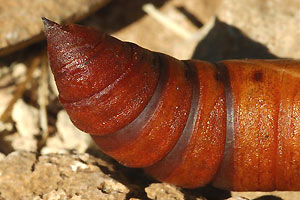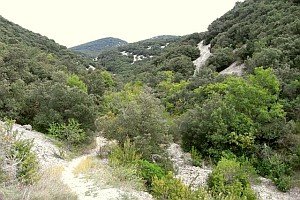Version 44 (neueste) vom 18. März 2024 um 21:58:09 von Erwin Rennwald
Wärmebedürftige südeuropäische Art (aus Nizza beschrieben), Falter und Raupe von Sommer bis Herbst. Falter aufgrund seiner Größe nicht mit anderen Hyles sp. zu verwechseln. Raupe an Euphorbia-Arten, insbesondere an der Nizza-Wolfsmilch (Euphorbia nicaeensis), Puppe überwintert.
Länder:

 +20Kontinente:EUASAF
+20Kontinente:EUASAF


 +20Kontinente:EUASAF
+20Kontinente:EUASAFInhalt
1. Lebendfotos
1.1. Falter
1: ssp. castissima (Austaut, 1883): Marokko, Hoher Atlas, M'Goun-Massiv, Ait Bou Gemes, Agouti, 1800 m. Kulturland, Felshänge. 1. August 2008 (Lichtfang-Foto: Axel Steiner), det. Axel SteinerForum
2-4: Frankreich, Languedoc-Roussillon, Dep. Gard, Süd Cévennes, Montdardier, Navas, e.l. 20. Mai 2011 (cult., det. & fot.: Allan Liosi)Forum
5: Frankreich, Languedoc-Roussillon, Dep. Gard, Süd Cévennes, Montdardier, Navas, e.l. 25. Mai 2011 (cult., det. & fot.: Allan Liosi)Forum
6-7: Frankreich, Hérault, Faugères, Les Moulins, 370 m, 25. / 27. Juni 2020 (det. & fot.: Dierk Baumgarten)
8: Griechenland, Prespa-Gebirge, Umgebung Argios Germanos, ca. 1700 m, Tagfund, 23. August 2020 (Freilandfoto: Thomas Bamann), det. Peter SchmidtForum
1.2. Raupe
1-2: Frankreich, Ardèche, Villeneuve de Berg, an Euphorbia characias, 18. September 2002 (manipulierte Freilandfotos: Allan Liosi), det. Allan LiosiForum
3: Frankreich, Hérault, Vallée de la Buèges, Nähe Weinbergen und Bach, 22.7.09 (Freilandfoto: Jochen Goldsche), det. Jochen Goldsche, conf. Andreas EberliForum
4: Frankreich, Hérault, St. Laurent-le-Minier, am Fuß des Pic d'Anjeau, ca. 630 m, steiniger Wegrand, 31. Juli 2009 (Freilandfoto: Jochen Goldsche), det. Jochen Goldsche, conf. Andreas EberliForum
5-12: (Raupen 5-8 L4 und 9-12 L5 : Frankreich, Languedoc-Roussillon, Dep. Gard, Montdardier, Navas, (D113a), N 43°56.244" E 3°34.242" leg. an Euphorbia nicaeensis, 17. Juli 2010 Allan Liosi, (Freiland und Studiofotos Raupen: 17/18/19 und 29. Juli 2010, Allan Liosi), cult. & det. Allan LiosiForum
1.3. Puppe
1-6: Frankreich, Languedoc-Roussillon, Dep. Gard, Montdardier, Navas, (D113a), N 43°56.244" E 3°34.242" leg. an 17. Juli 2010, (Studiofotos: 3. Okt. 2010, Allan Liosi), cult. & det. Allan LiosiForum
2. Diagnose
2.1. Geschlecht nicht bestimmt
2.2. Ssp. sheljuzkoi
2.2.1. Männchen
1: ♂, Kirgisistan, Innerer Tienschan, Naryn, Gebirgszug Moldotoo, Umgebung vom Moldo Ashuu-Pass, 2020 m, leg. Norbert Keil (Bernhard May, Rudolf Keller & Bernd Plössl), 17. Juli 2015, Lichtfang (coll., det. & fot.: Norbert Keil)
2-3: ♂, Kirgisistan, Innerer Tienschan, Naryn, Gebirgszug Moldotoo, Umgebung vom Kara Koo Ashuu-Pass, 2380 m, leg., coll. & det. Bernhard May (Norbert Keil, Rudolf Keller & Bernd Plössl), 16. Juli 2015 (fot.: Michel Kettner)
2.3. Erstbeschreibung
1: De Prunner (1798: 86) [nach Scan des Göttinger Digitalisierungszentrums [GDZ] mit schriftlicher Genehmigung des GDZ. Besitzerin der Vorlage: Niedersächsische Staats- und Universitätsbibliothek]
3. Biologie
3.1. Habitat
1: Frankreich, Hérault, St. Laurent-le-Minier, am Fuß des Pic d'Anjeau, ca. 630 m, steiniger Wegrand, 31. Juli 2009 (Freilandfoto: Jochen Goldsche)Forum
2-5: Frankreich, Languedoc-Roussillon, Dep. Gard, Montdardier, Navas (D113a), 19., 24., 25. und 29. Juli 2010 (Fotos: Allan Liosi)Forum
6: Frankreich, Ardèche, St. Maurice d'Ibie, Vallée de l'Ibie und Umgebung, 13. September 2008 (Foto: Allan Liosi)Forum
3.2. Raupennahrungspflanzen
1: Euphorbia nicaeensis: Frankreich, Languedoc-Roussillon, Dep. Gard, Montdardier, Navas (D113a), 24. Juli 2010 (det. & Foto: Allan Liosi)Forum
2: Euphorbia characias: Frankreich, Rhône-Alpes, Ardèche, St. Maurice d'Ibie, Vallée de l'Ibie und Umgebung, 24. Mai 2008 (det. & Foto: Allan Liosi)
3: Euphorbia characias: Frankreich, Rhône-Alpes, Ardèche, Lagorce, 13. September 2008 (det. & Foto: Allan Liosi) [Forum 2+3]
3.3. Nahrung der Raupe
- Euphorbiaceae:] Euphorbia nicaeensis (Nizza-Wolfsmilch)
- Euphorbiaceae:] Euphorbia characias (Palisaden-Wolfsmilch)
Wichtigste Raupennahrungspflanze ist die Nizza-Wolfsmilch (Euphorbia nicaeensis).
4. Weitere Informationen
4.1. Etymologie (Namenserklärung)
„die aus Nizza, wo die Art entdeckt wurde.“
4.2. Andere Kombinationen
- Sphinx nicaea De Prunner, 1798 [Originalkombination]
4.3. Synonyme
- Sphinx cyparissiae Hübner, [1813]
- Hyles carnea (Austaut, 1889)
- Hyles albina (Oberthür, 1916)
- Hyles margine-denticulata (Oberthür, 1916)
- Hyles rubida (Oberthür, 1916)
4.4. Unterarten
- Hyles nicaea lathyrus (Walker, 1856)
- Hyles nicaea castissima (Austaut, 1883)
- Hyles nicaea orientalis (Austaut, 1905)
- Deilephila nicaea crimaea A. Bang-Haas, 1906
- Hyles nicaea sheljuzkoi (Dublitzky, 1928)
- Celerio nicaea libanotica Gehlen, 1932
4.5. Faunistik
Hristova & Beshkov (2016: 573) schließen die Art aus der Fauna Bulgariens aus: “Tuleschkow (1931) firstly recorded this species for Bulgaria from Belasitsa Mt., 1800 m a.s.l., later Ganev (1984a) quoted this report. Hyles nicaea has never been reported again from the country so Tuleshkov’s data remains unconfirmed. Here the species is excluded from the list of the Bulgarian fauna owing to a likely misidentification and confusion with the large females of Hyles euphorbiae seems very possible.”
4.6. Literatur
- Hristova, H. O. & S. V. Beshkov (2016): Checklist of the Superfamilies Cossoidea, Thyridoidea, Drepanoidea, Lasiocampoidea, Bombycoidea and Noctuoidea: Notodontidae (Insecta: Lepidoptera) of Bulgaria, with Application of the IUCN Red List Criteria at National Level. — Acta zoologica bulgarica 68 (4): 569-576. [PDF auf acta-zoologica-bulgarica.eu]
- Erstbeschreibung: De Prunner, L. (1798): Lepidoptera pedemontana. I-LII, 1-124. Augusta Taurinorum (Mathaeus Guaita). — Digitalisat der Bayerischen Staatsbibliothek München: [86].









































